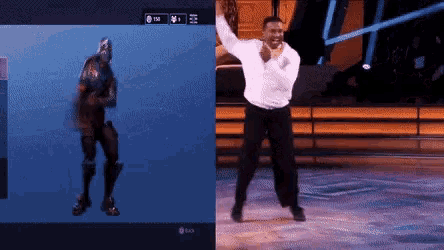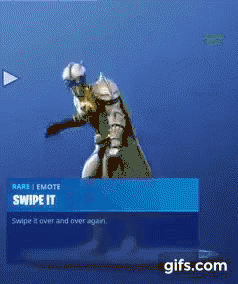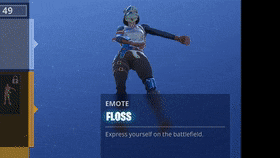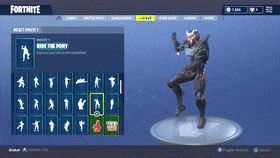Epic Games’ Fortnite is at the center of controversy surrounding copyright and the limits of intellectual property laws. With three high-profile figures filing lawsuits against the company for marketing their likeness, the video game phenomenon prompts a conversation about who owns culture.
The Battle Royale style game features customizable avatars, for which users can purchase “emotes,” specific gestures or dance moves that avatars can perform in the game. The problem is that “emotes” are designed to appeal to millions of international users, with many replicating wildly popular dance trends and cultural icons. Select “emotes” are based on Snoop Dogg’s “Drop It Like It’s Hot” dance, Psy’s “Gangnam Style,” and Donald Faison’s “Poison” dance from the US sitcom Scrubs.
 Tenor
Tenor
However, Fortnite’s creators did not secure licenses to recreate these artists’ likenesses in their game. But it’s unclear under U.S. law whether or not a segment of choreography even qualifies for copyright protection. As highlighted by the Wall Street Journal, the U.S. Copyright Office’s stance on choreography dictates that it “cannot register short dance routines consisting of only a few movements or steps with minor linear or spatial variations, even if a routine is novel or distinctive.” They elaborate that “social dance steps and simple routines” are not protected by copyright “even if they contain a substantial amount of creative expression.”
In fact, few dance moves have been successfully copyrighted. Michael Jackson was able to patent his impressive leaning move featured in the “Smooth Criminal” music video–but only because he invented the special shoe that makes it possible. Since each one of Fortnite’s “emotes” is a short movement and not a creative song or dance of its own, copyright lawyers can’t agree about whether or not infringement laws apply.
The first “emote” to challenge what constitutes copyright infringement is called “Swipe It,” which replicates the dance move recognizable as the “Milly Rock.” Its creator, rapper 2 Milly, born Terrence Ferguson, was the first to sue the game with allegations that Fortnite violates copyright law by selling his “signature” choreography. He told Rolling Stone, “My dance is my signature. Everybody would tell you, from here to Alaska, ‘Hey, that’s the Milly Rock.’ I don’t mind people doing it in their videos. What I do mind is when somebody takes what I created and sells it.”
While the “Milly Rock” became a viral dance move in 2015, it isn’t a full choreography set. Christine Lepera, attorney for music industry giants like Drake and Timbaland, argues that a single dance move is precluded from copyright infringement: “You cannot copyright certain dance moves that are generic. From what I’ve seen online, I’ve done these [Milly Rock] moves in hip-hop [dance] class for years — it’s a pivot, heel-out, heel-out, and swing your arms.”
 Amino Apps
Amino Apps
The second creator to file charges against Epic Games is Alfonso Ribeiro, best known for playing Carlton Banks on The Fresh Prince of Bel-Air. He alleged that the “emotes” called “Fresh” plagiarizes the “Carlton Dance,” made famous by the beloved sitcom character Ribeiro played in the 90s. However, copyright lawyer Scott Alan Burroughs argues that an actor doesn’t own his character’s stylized, or “signature,” movements, since the character is owned by the production company. Burroughs says, “[Ribeiro] created and performed that dance while acting on a television show he was a performer on, so it was likely ‘work for hire’ that belongs to the show’s producers.”
The third creator to file charges against the game is the mother of Russell Horning, a 17-year-old content creator on YouTube who popularized “the floss” dance. Again, Fortnite sells a “Floss” emote that the Hornings claim infringes upon their legal right to share in the profit made through dance move.
 2048
2048
But how much money does Fortnite make from selling “emotes?” For that matter, how does a game that’s technically free to play earn Epic Games over $2 billion in 2018? When the Fortnite App launched on Apple’s IOS in April, the game reportedly made $2 million a day, making history as the first to net over $1 billion by following a free-to-play model.
The secret–and the root of the controversy–is the game’s profit from microtransactions. While all users can play the entirety of the game for free, they have the option of purchasing in-game currency, called “V-bucks,” which allows players to customize their gaming experience. With an exchange rate of approximately 1 USD to 100 V-bucks, users are offered deals to spend anywhere from $2 to $20 on cosmetic skins, game modes for their characters, and, of course, dances. Michael Pachter, an analyst at Wedbush Securities, noted, “On the revenue side, [Fortnite has] done something that’s really unique, which is come up with a perception of exclusivity.” He added, “If you see another player in a leopard skin and go to the store and see it’s no longer available, you think, Shoot, I’ve got to move on it next time.”
All three complainants are represented by the law firm Pierce Bainbridge Beck Price & Hecht LLP. In addition to copyright infringement, the lawsuits allege violations of the rights to publicity, which are creators’ rights to control and profit off any use of their likeness, name, or other distinct traits. David L. Hecht, the representative for 2 Milly, Ribeiro, and Horning, insists that his clients have exclusive rights to the cultural trends they’ve instigated, stating, “I will say you can absolutely copyright choreography, and you can leave it there.” Whether U.S. law is in agreement with him is for a judge to decide in 2019.

Meg Hanson is a Brooklyn-based writer, teacher, and jaywalker. Find Meg at her website and on Twitter @megsoyung.
- ‘Fortnite’ maker Epic Games may face more lawsuits for dance moves ›
- A Real-World Battle Over Dancing Avatars: Did Fortnite Steal the … ›
- Fortnite sued over The Floss: Can you copyright a dance move … ›
- Celebrities suing ‘Fortnite’ over dance moves – CNN Video ›
- Fortnite Dance Lawsuits: What’s The Story Behind Them? | Billboard ›
- Real-Life Lawyer Shares Insight on Fortnite Dance Move Lawsuits ›
- ‘Fortnite’ Dance Lawsuits: Carlton, Floss, Milly Rock Copyrightable … ›
- How Fortnite’s dance moves sparked new lawsuits against Epic … ›
- The Fortnite Dance Lawsuits Are Super Important (Seriously … ›
- Epic and Fortnite’s dance lawsuits – Polygon ›





